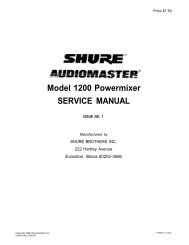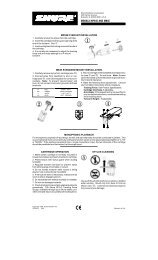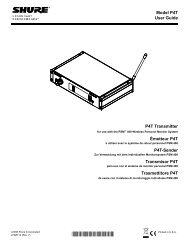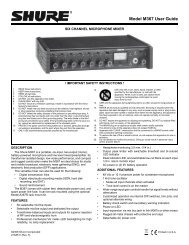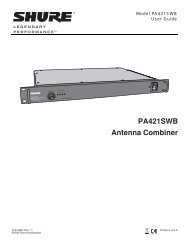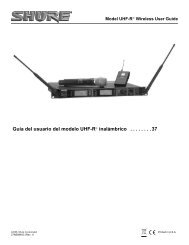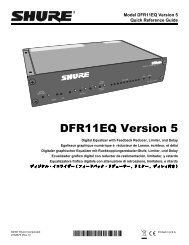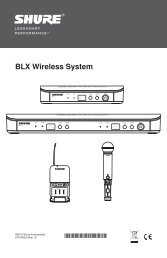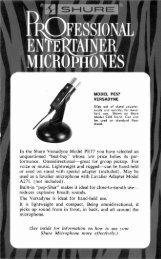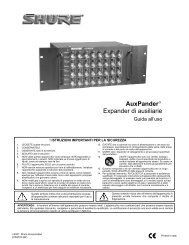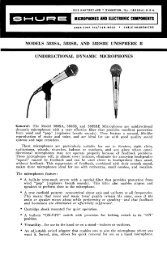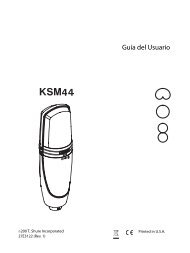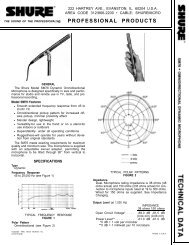Shure M267 User Guide English
Shure M267 User Guide English
Shure M267 User Guide English
Create successful ePaper yourself
Turn your PDF publications into a flip-book with our unique Google optimized e-Paper software.
Mix BusDirect access to the mixing bus is provided through therear-panel MIX BUS phono pin jack. This provision is madeprimarily to facilitate stacking or “multing” <strong>M267</strong>s toachieve additional input capacity without losing any inputs.With two <strong>M267</strong>s, for example, the two mixing buses are directlyconnected, providing two independent master gaincontrols and two isolated line amplifiers with eight individuallycontrolled inputs. Since the buses are directly paralleled,a 6 dB drop in gain will occur; and the master or inputcontrols must be increased to compensate. Noise specificationsare not adversely affected by this interconnection.Mix bus interconnection can also be made with other<strong>Shure</strong> mixers, such as the M268, FP42. etc.VU MeterThe VU meter is factory-calibrated for use with a 600 Ωterminated line. The VU RANGE switch on the rear panelselects either a +4 or +8 dBm output at 0 VU meter indication.(This switch changes the meter indication but doesnot change the actual output level.) Microphone outputlevels are 50 dB below line output. The +4 range is recommendedfor normal use to provide approximately 14 dB ofheadroom from operating level to clipping level.The VU meter is illuminated by two No. 86 lamps operatingwell under their normal ratings for a life expectancy ofgreater than 10,000 hours. The lamps are only lit duringac operation. Consequently, the illumination serves as avisual alarm if the ac is interrupted and the unit hasswitched to battery.The VU meter is connected on the primary side of theoutput transformer to assure protection from any dc levelon a telephone line.HeadphonesThe headphone outlet appears at the front-panel jackpanel designated PHONES. The two-circuit phone jackwill accommodate most stereo or mono headphones. Theoutput level is sufficient to provide high volume for use innoisy environments.Note that the headphone output level is also highenough to use as an auxiliary unbalanced line feed to drivea tape deck or a power amplifier.The tip and ring connections of the headphone plugs arein phase with pin 3 of all input and output connectors, andwith the tip of the MIX BUS jack.Tone OscillatorThe highly stable, low-distortion tone oscillator providesfor line test and level checks. The oscillator is instantly activatedby the front-panel INPUT 1/OSC 1 switch; its levelcan then be controlled by the INPUT 1 gain control on thefront panel. The tone oscillator frequency is 1,000 Hz, andthe signal appears on both the line and microphone outputs,as well as the headphone and mix bus connectors.The oscillator should be switched off (INPUT 1 position)when not in use.Phantom PowerThe rear-panel PHANTOM OFF/ON switch controls theapplication of phantom power for condenser microphones,such as the <strong>Shure</strong> SM81 and SM87A, to all inputs. Withthe switch on and the rear-panel MIC/LINE switches in theMIC positions, +30 Vdc is applied to pins 2 and 3 of eachinput connection. Series current-limiting resistance is 3.3kΩ for each input. When using other condenser microphoneswith the <strong>M267</strong>, verify that the voltage and resistancerequirements are compatible.Note that the phantom power cannot normally be appliedto the inputs with the MIC/LINE switches in the LINEposition.IMPORTANT: Do not turn the PHANTOM switch on whenusing unbalanced low-impedance microphones; objectionablehum will result. Turn off the PHANTOM switchwhen condenser microphones are not being used.Use only high-quality cable. Intermittent shorts betweenbroken shield wires and balanced conductors will cause offensivenoise transients in the system.BATTERY OPERATION AND EXTERNAL POWERINGIn addition to ac operation, the <strong>M267</strong> can be operatedfrom an internal battery pack. Current drain is typically 17mA at +8 dBm output level and typically 15 mA at + 4 dBm.Battery power is recommended both for remote, on-locationoperation, and as an emergency backup source incase of failure of the ac power.Access to the battery compartment is provided at thebottom of the chassis. Three 9-volt alkaline batteries powerthe <strong>M267</strong> at full rated output. Use alkaline batteries formaximum life. Duracell MN1604A or Eveready 522 arerecommended. Battery life is approximately 20 hours at +4dBm continuos use. Note that battery operation with phantompower loads and high level headphone monitoring willincrease battery drain.With batteries in the battery compartment, the <strong>M267</strong> willautomatically and silently switch to battery operationshould the ac voltage fall below a suitable level. If the acpower fails completely, the VU meter lamps will go out, providinga visual indication of line failure.Battery condition can be determined by using the BATTCHECK switch on the front panel. Activate the BATTCHECK switch and observe the VU meter. A new set ofbatteries will give about a +2 VU indication. Battery conditionis good if the reading is above 0 VU; a lower readingmeans that new batteries are required for proper operation.Note that the <strong>M267</strong> power switch must be turned onto check battery condition.Telephone InterconnectionWhen using the <strong>M267</strong> connected directly to a telephoneline, check to see whether the local telephone company requiresan interface coupler between the <strong>M267</strong> and the telephoneline. If a coupler is required, make certain the couplerselected and the wiring arrangement are incompliance with the telephone company regulations.4



